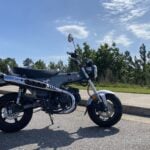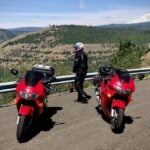We ride (drive?) the 2021 Polaris Slingshot SL
For the past couple of years, several of the Road Dirt crew have periodically nudged me, saying, “We should review a Polaris Slingshot.” I’ve resisted, declaring, “We are Road Dirt MOTORCYCLE Media. The Slingshot is not a motorcycle.” I was bound to eat my words eventually.
A couple of months back, Polaris reached out to us via Kelly with The Brand Amp (their marketing partners), asking if we’d be interested in sampling a 2021 Slingshot SL for a couple of weeks. To the guffaws and “I told you so” ribbings of my compatriots, I of course agreed, and subsequently dined on my words.
As we would say down here in the Deep South, “That thing is a hoot to drive.”
We picked the Slingshot up from Mall of Georgia Indian Motorcycle, who had it serviced, cleaned and fueled up for us. Pierce Carlson, their rep, gave me a quick rundown on the SL, as I’ve never even sat in one before, much less driven one. There was no intimidation factor with it, once I understood how easily the Slingshot is to crank up and ride. So I throttled out toward home, taking the long way of course, to familiarize myself with this completely new (to me) three-wheeled contraption.
First introduced by Minnesota-based Polaris Industries back in 2014 as a 2015 model, the tri-wheeled “autocycle” as they dub it has seen many refinements, from all-manual to the new “automatic” AutoDrive transmission (more on that in a bit), to an all-new proprietary powerplant engine, the ProStar 2.0L replacing the previous GM Ecotec I4, and everything in between. The overall styling has remained the same, with sharp, angular lines and their “FR” (front engine, rear-wheel drive) layout.
In riding (driving?) the Slingshot SL, familiarizing myself with this unique machine and preparing to write about it, I’ve had to walk the tightrope of my motorcycle riding perspective while reviewing this for what it is and not comparing it to a two-wheeled bike. So that’s what I’ll endeavor to do here.
First, here’s some deets on the Polaris Slingshot SL that we find interesting.
Polaris replaced the original GM Ecotec powerplant in 2020 with their own motor, the ProStar 2.0L, slightly smaller in displacement than the GM, but also lighter and better suited to their design upgrades and new transmission. The ProStar is a 1997cc, 122ci in-line DOHC four, making 178 hp at 8500 rpm, 120 lb-ft of torque at 5,500 rpm. And since it weighs in at just a tick or two under 1700 lbs., that’s a pretty stout power-to-weight ratio, 9.3 lbs/hp to be exact. And with a claimed top end of 125 mph, there’s more than enough hooligan under that huge hood to satisfy your inner need for speed. Or get you arrested.
The Slingshot is all party out front, business out back. Setting lower and wider than a Corvette, the Slingshot rolls on Kenda SS-799 ZR-rated high performance rubber, pinches on vented cast iron 298mm disc brakes fore and aft, and sports a single-sided swingarm and belt drive to the rear wheel. And with a 9.77 gal, 37.1 L fuel tank behind the seats, making about 35/40 estimated mpg, the Slingshot has some long legs.
The engine, tranny and final drive are impressive.
The first few days I had the Slingshot, we had beautiful early September weather here in the Southeast, so I rolled every day, whether up town for some wifey “to-do” errands, some local business, or just blasting out down our abundant curvy country roads. The tranny in the SL model is center console, push button actuated, with Reverse, Neutral, Drive and Manual. Depress the brake pedal, switch between the four modes, and off you go. Except now in 2021, Polaris offers the all-new “AutoDrive” 5-gear transmission, to attract more customers who might not feel comfortable with the “old-school” clutch and shifter method many of us grew up on. AutoDrive is sort of a combination of a manual and an automatic, in that the SL has paddle shifters up on the steering column for Manual mode, and no clutch pedal. Yet the rider can still shift up/down as desired even in Drive (automatic), whereas if the revs get too low when slowing down in Manual, the AutoDrive will downshift itself, rather than chug or stall the motor. I found that handy on occasions when I was paddle shifting in “M” mode, matching revs to gear shifts, and would forget to downshift approaching a stop. Or when I wanted to upshift faster and higher in the rev range than the slow, methodical shifting in Drive.
Speaking of stops, all Polaris Slingshot models now come equipped with a “Hill Hold” feature, that activates to keep the vehicle from rolling back while the rider prepares to throttle forward at a light or stop sign. It’s a 3-second hold, just enough time to accelerate forward if needed. The other feature I liked for stops, parking lots, etc., is the back-up camera for “R” or Reverse. Handy, given the tall “F1” style rear section behind the cockpit. Between the rear view mirrors and back-up camera, the rider has good behind field of view.
Nice cockpit layout.
The 2021 Polaris Slingshot SL employs a rack-and-pinion, Variable Speed Sensitive Electronic Power Steering 2.0, so it responds to every movement. Very responsive handling, and turns on a dime, modulated of course by switchable traction control and electronic stability control. I liked the small, flat bottomed steering wheel, wrapped in leather. Very sports car-like. Thumb-press buttons on the wheel can activate cruise control, can switch between Comfort and Slingshot mode (while riding), adjust sound system volume and and track control, Bluetooth voice command, and toggle between screens on the center console Ride Command display.
That center console 7-inch customizable TFT “Ride Command” display holds a wide variety of info that can be shown and scrolled through via a menu button on the steering wheel. Ours had four potential pages- two displaying vehicle and trip data (miles to E, voltage, engine temp, etc.), one for entertainment (music, Bluetooth, etc.) and one for navigation if equipped (ours was not). The main dash is an LCD display of fuel consumption, gear position, speed in mph or kph, bookended by an analog speedo and tach with odo, trip meters, outside and engine temps, among others. There are two ride modes, Comfort and Slingshot, switchable on the fly (red button on the steering wheel). Comfort softens and slows the gear shifting and shifts at lower revs, while Slingshot makes shifts sharper and higher in the rev range. This was where I kept it most of the time, to be honest. Too much fun.
The Slingshot info screens are customizable, with different sets of data that can be drag-dropped to suit. And yes, I have good taste in music.
Okay, some riding impressions.
Minnesota-based Polaris calls the Slingshot an “autocycle”. Some states classify it as a motorcycle, requiring helmet and gear, while others do not. It’s really neither. And yet it’s a bit of both. I just like to refer to it as a “roadster”. It’s not fully an automobile, so isn’t subject to auto manufacturers’ stringent safety features, i.e. airbags, lockable doors, etc. Yet the Slingshot obviously is not your typical motorcycle either, given the fact that the rider (driver?) sits down in a high-backed seat, straps in with a seatbelt, grips a steering wheel, and has no clutch to engage (the R model does, however).
For whatever it is, the Polaris Slingshot SL is a load of fun.
The profile is low, lean and mean-looking from the front, yet somewhat unsightly and ungainly from the rear. Motojournalist Kevin Duke once quipped about the Slingshot, “The Slingshot looks like a Le Mans prototype race car from the front and, from the rear, like a plastic chairlift with a wheel stuck on back.” Kind of funny, kind of true.
The Slingshot is a hoot in the sweepers.
Our test model came equipped with both the “Excursion” and “Drive” packages. Excursion gives two sealable compartments up on the dash, one between the seats, two zipables down low on the outside of both seats, as well as cavernous lockable, waterproof compartments behind each seat, and a huge, lockable glove box in front of the passenger. Drive package brought the “M” drive and paddle shifting capability, as well as adjustable heating/cooling elements for both seats. In all, we found this a very well-equipped beast.
As stated, the Slingshot sits extremely low, about 5.4 inches off the pavement. I had to be extra careful to stay on the road- tipping onto the road shoulder can scrape bottom, as can riding over sharp angled hills or dips. While driving down to visit my mom one day, I got slightly pushed off to the road shoulder once by a pickup pulling a pontoon boat trailer coming the opposite way, hogging nearly the whole narrow road. Even with the tire just barely slipping off road, it scraped and bottomed out. That was a butt-pucker moment, for sure. No damage done, save some front right fairing scraping underneath, but reminded me how low and wide the machine is.
I liked the keyless ignition, with proximity key fob. You depress the brake pedal, which activates the system, then push the “Start/Stop” button to crank it over. An old style pull-up handbrake and release in the center console is essential to the ignition system- you must pull up the handbrake when shutting down, or the system will beep and not shut down until you do. Nice safety feature, really.
My dear ole Mom about to charge off into the sunset with me. I think she had fun- “Let’s turn down that road, see where it goes…”
The Slingshot engine and exhaust are loud, the transmission runs right between the seats, and both “pilot” and passenger can feel every vibration, shift, etc., as well as smell a slight exhaust hint. Heat from the engine and tranny is felt on your legs in the cockpit, though not terribly so. I took my mother for a ride in it and she absolutely loved the jaunt, but noted the mild heat around her lower legs, which since the exhaust exits on the right side beneath the passenger, was not surprising.
The Slingshot is incredibly fun to ride. Sitting so low to the ground, open canopy, the riders feel, hear, and smell everything. It’s a noisy ride, vibrations are felt from the engine and transmission in every gear, and you feel every bump and irregularity in the road. But that’s also what’s attractive about the Slingshot- It’s a very visceral experience for all the senses. Like I said, I keep coming back to the “roadster” description, like the old open-wheeled, open cockpit hot rods our fathers and grandfathers used chop and race back decades ago, just with modern tech and design.
With all those ponies under that enormous hood, combined with the ABS, Traction Control, Electronic Stability Control, and shod with those ZR-rated tires, the Sling’s low, wide stance makes for incredible handling. It’s so planted in corners. Little wonder I see plenty of these up in the North Georgia mountains, carving up the twisties. One of my brothers noted, “I see them everywhere on the roads around Orange Beach.” Oceanfront or highlands, the Slingshot is a great choice.
Cool from the front, kind of goofy looking from the back.
A few caveats, and of course, every vehicle has them.
The brakes were a concern for me. The Slingshot runs twin vented 298 mm discs up front, a 298 mm single in back, but feel is mushy at best. I had to about press the brake pedal to the floor several times to feel like it was going to stop in hard-braking situations. Not confidence inspiring.
I also didn’t like the light setup for night riding. The single LED headlight doesn’t project far enough out front, even in high beam. During a ride back in the dark one evening, I discovered the main center headlight seemed to be pointed almost straight down, even in high beam. That made for a slow, nerve-racking drive home. I took it back to Indian Mall of Georgia to see if they could adjust it up, which they did, but it still points too low and is too soft a light to really venture out after dark. The Slingshot needs better, brighter lights, pointing further out, to be a better all-rounder.
The Slingshot SL boasts an impressive Rockford Fosgate 100w sound system, yet with all the engine, tranny, and open cockpit wind noise at speed, you have to turn the volume up considerably to adequately hear the system, and then it’s somewhat distorted. Kind of nullifies this expensive sound system at speed.
Riding with my girl. Are frequent selfies a sign of satisfaction?
But in all, I really enjoyed my time with the Slingshot SL, as did those who rode with me. My mom, who is close to 80 now, quipped, “It reminds me of your father’s old ’35 Ford hot rod he had when we were teenagers. The noise, the heat, the vibration… I like it!” Mom, you ole rebel, you. My wife Lisa, who never rides my motorcycles with me, grabbed a helmet as soon as I got home with it the first day, exclaiming, “Take me for a ride!” That was the highlight for me. We in fact took multiple rides, and she thoroughly enjoyed herself, which made me happy. We did a day trip on it, as well as several around-town jaunts, and Lisa loved every minute. Spending the day with my honey along for the ride, would alone be about enough to convince me to buy one. She even was my “videographer” several times, as evidenced in our video review. The Slingshot is definitely best experienced with companionship.
To really get jiggy with a Slingshot, check out the R model. Manual tranny, foot clutch, traditional stick shift in center console, makes 203 hp at 8,250 rpm and 144 lb-ft of torque at 6,500. That’s the one I’d like to ride. The wife, not so much. She really liked this SL model, even considering taking a test spin in one herself at some point. We can arrange that…
C’mon, you know you’d like to thrash one.
The 2021 Polaris Slingshot is an attention-getter, and deservedly so. Go find your local Polaris/Indian dealership, and take one for a test spin. It’s easy to see why so many are entering our Powersports world via this “autocycle”. And if it gets more people out on the roads with us, well, I say that’s a very good thing.
Check out more deets and digits on the Slingshot here:
*photos and footage by Phil Gauthier, Lisa & Rob Brooks





































here’s me getting sideways in mine!
https://youtu.be/VwK21bWtx8Y
Rock on, Bread!